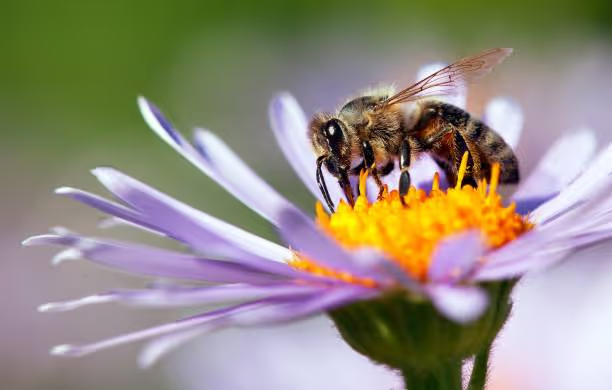How Hidden Valley Orchards Supports Local Wildlife and Pollinators

October 27, 2025

Introduction
At Hidden Valley Orchards in Lebanon, Ohio, every bloom, buzz, and bird call plays a part in a much larger story, one of balance, biodiversity, and care for the land. As stewards of nature, we believe that a thriving orchard depends on a healthy ecosystem, where pollinators and wildlife can flourish side by side with our crops. From bee hives and butterfly gardens to sustainable soil and water management, Hidden Valley is proud to nurture not only delicious produce but also the living world that makes it all possible.
The Vital Role of Pollinators in Orchard Health
Pollinators are the quiet heroes of every harvest. Bees, butterflies, and even certain bird species play essential roles in fertilizing fruit trees, transferring pollen from blossom to blossom, and ensuring strong yields and flavorful crops.
At Hidden Valley Orchards, these natural helpers are woven into the fabric of farm life. In spring, you can see bees busy among the apple blossoms, butterflies dancing across flower fields, and hummingbirds sipping nectar near the orchard edges. Each species contributes to a thriving ecosystem, ensuring trees bear abundant fruit and surrounding plants continue to flourish.
Pollinators are also key indicators of environmental health. Their presence signals clean air, balanced soil, and sustainable farming practices. Protecting them means protecting the future of local agriculture, something Hidden Valley takes to heart in every season.
Conservation Initiatives at Hidden Valley Orchards
Bee Hives and Pollinator Gardens
Hidden Valley is home to active bee hives that provide safe, year-round shelter for honeybees, one of the most critical pollinators in our ecosystem. These hives not only support orchard pollination but also produce local honey enjoyed by guests in our market and bakery.
In addition to managed hives, we’ve created pollinator gardens filled with native wildflowers such as milkweed, black-eyed Susans, and coneflowers. These plantings give bees, butterflies, and other pollinators a consistent source of nectar and habitat from early spring through late fall. Visitors can stroll near these gardens to watch pollinators in action and learn more about how vital they are to food production.
Wildlife-Friendly Land Management
Beyond pollinators, Hidden Valley is home to a variety of wildlife, from songbirds and owls to rabbits, deer, and beneficial insects that contribute to the farm’s ecological balance. Our land management practices are designed to keep this harmony intact.
We limit pesticide use, relying on natural pest control methods such as companion planting and beneficial insects. Portions of the property are left intentionally wild, maintaining natural food chains and giving native species places to nest and feed. Every action, from mowing schedules to pruning cycles, considers how it will impact the animals that call Hidden Valley home.
Sustainability Practices for Long-Term Balance
Caring for wildlife begins with caring for the land. Hidden Valley Orchards takes a holistic approach to sustainability that focuses on soil health, water conservation, and biodiversity.
Organic Soil and Water Management
We enrich the soil with compost, organic fertilizers, and natural mulch to encourage microbial activity and long-term fertility. Our irrigation systems are calibrated for efficiency, minimizing runoff and water waste. This not only conserves resources but also protects nearby waterways from pollution.
Supporting Biodiversity Through Native Plantings
By incorporating native trees, shrubs, and flowers, Hidden Valley strengthens the local ecosystem’s resilience. Native plants attract beneficial insects, provide food for pollinators, and improve soil stability. The result is a self-sustaining environment where orchard crops and wild flora thrive together, a living reminder that nature grows best when it grows in balance.
Visitor Involvement: How You Can Help
Every visitor plays a role in protecting the wildlife and pollinators that make Hidden Valley Orchards so special.
Eco-Friendly Visit Tips
- Stay on designated paths to protect pollinator gardens and wildlife habitats.
- Avoid picking or disturbing flowers outside U-Pick areas; they’re essential for pollinators.
- Recycle and dispose of waste responsibly.
- Bring a reusable water bottle and reduce single-use plastics during your visit.
Get Involved
Hidden Valley occasionally hosts educational workshops on pollinators, sustainability, and conservation. Guests can learn how to plant bee-friendly gardens at home, make natural bird feeders, or support Ohio’s native species. Future volunteer opportunities may also include seasonal planting and pollinator garden maintenance, a hands-on way to contribute to the orchard’s environmental mission.
Conclusion: Growing in Harmony with Nature
Hidden Valley Orchards is more than a farm; it’s a living ecosystem where people, plants, and wildlife thrive together. Every flower that blooms and every bee that buzzes reminds us that sustainability starts right here, in the soil beneath our feet.
By caring for pollinators, protecting wildlife habitats, and practicing responsible farming, we’re ensuring that Lebanon’s natural beauty endures for generations to come. We invite you to visit, explore, and experience how nature and community grow side by side at Hidden Valley Orchards.
